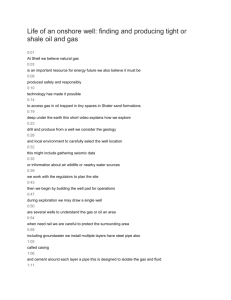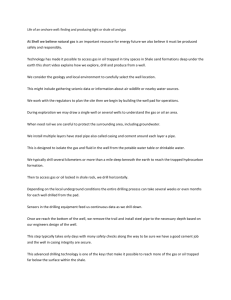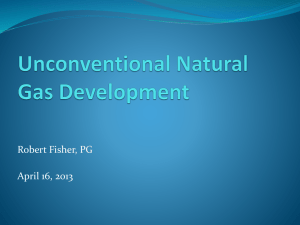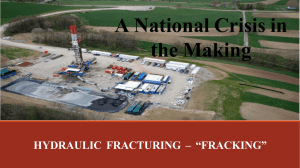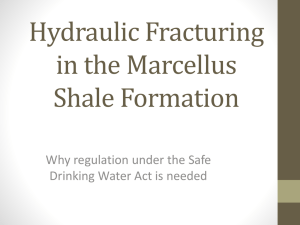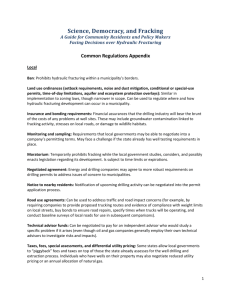The Process of Hydraulic Fracturing
advertisement
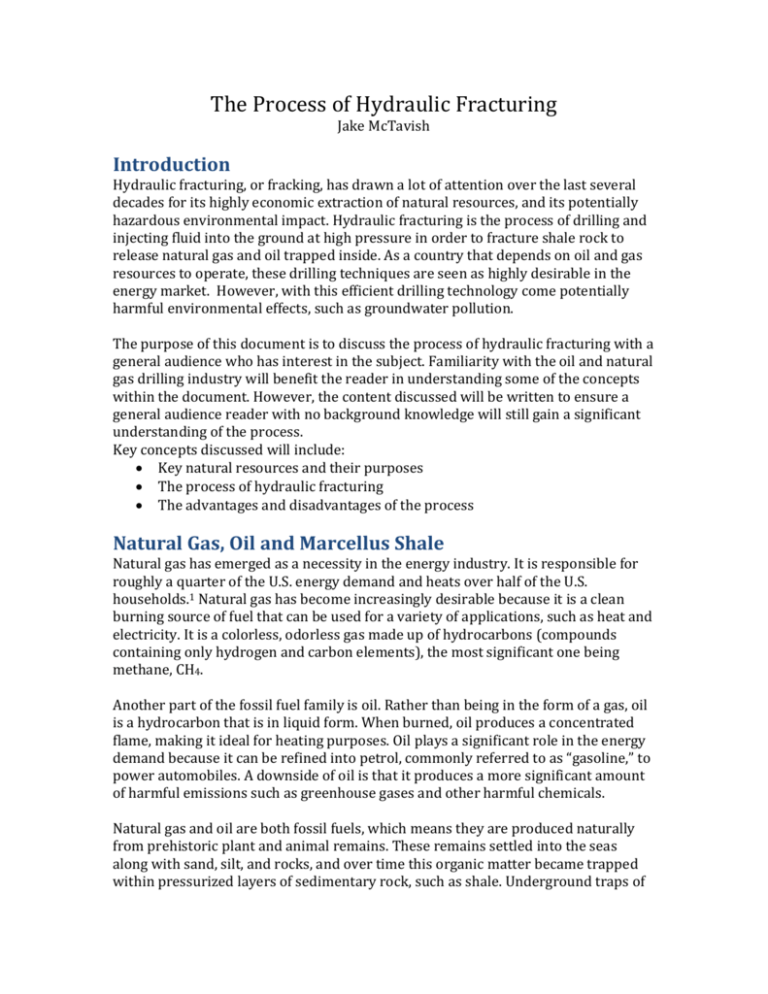
The Process of Hydraulic Fracturing Jake McTavish Introduction Hydraulic fracturing, or fracking, has drawn a lot of attention over the last several decades for its highly economic extraction of natural resources, and its potentially hazardous environmental impact. Hydraulic fracturing is the process of drilling and injecting fluid into the ground at high pressure in order to fracture shale rock to release natural gas and oil trapped inside. As a country that depends on oil and gas resources to operate, these drilling techniques are seen as highly desirable in the energy market. However, with this efficient drilling technology come potentially harmful environmental effects, such as groundwater pollution. The purpose of this document is to discuss the process of hydraulic fracturing with a general audience who has interest in the subject. Familiarity with the oil and natural gas drilling industry will benefit the reader in understanding some of the concepts within the document. However, the content discussed will be written to ensure a general audience reader with no background knowledge will still gain a significant understanding of the process. Key concepts discussed will include: Key natural resources and their purposes The process of hydraulic fracturing The advantages and disadvantages of the process Natural Gas, Oil and Marcellus Shale Natural gas has emerged as a necessity in the energy industry. It is responsible for roughly a quarter of the U.S. energy demand and heats over half of the U.S. households.1 Natural gas has become increasingly desirable because it is a clean burning source of fuel that can be used for a variety of applications, such as heat and electricity. It is a colorless, odorless gas made up of hydrocarbons (compounds containing only hydrogen and carbon elements), the most significant one being methane, CH4. Another part of the fossil fuel family is oil. Rather than being in the form of a gas, oil is a hydrocarbon that is in liquid form. When burned, oil produces a concentrated flame, making it ideal for heating purposes. Oil plays a significant role in the energy demand because it can be refined into petrol, commonly referred to as “gasoline,” to power automobiles. A downside of oil is that it produces a more significant amount of harmful emissions such as greenhouse gases and other harmful chemicals. Natural gas and oil are both fossil fuels, which means they are produced naturally from prehistoric plant and animal remains. These remains settled into the seas along with sand, silt, and rocks, and over time this organic matter became trapped within pressurized layers of sedimentary rock, such as shale. Underground traps of oil and gas are known as reservoirs. These reservoirs can be anywhere from hundreds of feet to miles below the ground surface. The hydraulic fracturing process utilizes layers of Marcellus shale rock, which can house deposits of natural gas or oil, usually found between 1 to 2 miles underneath the surface. The Marcellus shale is fractured, or broken, in order to free these trapped energy resources.2 Hydraulic Fracturing Process Figure 1 Hydraulic fracturing is a multi-step process that takes a few months to establish, but can pump oil and gas for 20 to 40 years. Typically, it takes a few weeks to prepare the drilling sight, a month to drill the well, and one to three months of collection and completion activities, which will be discussed later on. Drilling To begin the process, a location must be chosen where Marcellus shale is accessible. Once a well site is established, a drilling rig will drill a large bit down through the earth until the Marcellus shale layer is reached. As shown in Figure 2, the key parts of the diagram to focus on are boxed in red. This includes the casing, cement, and drill bit. However, it is to be noted that the other mechanical and structural parts of the rig are essential to ensure that the bit is driven, and do serve a purpose. The drill bit is the metal cutting element that is rotated and driven through the layers of earth well below the groundwater table and through several layers of rock until the oil and gas reservoirs are reached. As the drill bit is entering the earth, the Figure 2 casing, which is a heavy steel pipe, lines the walls of the hole to prevent caving in, and also serves to prevent any fluid used from polluting any groundwater supply. The cement is then used to fill the void space between the wall of the hole and the metal casing. This serves to supply structural support to the casing and to further protect any fluids from contaminating groundwater supply. When the Marcellus shale layer is reached, the drill is turned horizontal, as shown in Figure 1, and extended for anywhere up to a few miles in the horizontal direction. The horizontal drilling is useful because it allows the same well site to reach natural resources up to miles away, reducing the need for additional drilling sites in the area. Fluid Injection The key ingredient to fracturing the shale is the pumping fluid. Once the well has been drilled and cased, an explosive perforating tool is sent down the casing to the point of the targeted gas or oil. The perforating tool creates holes through the casing, cement and into the shale so that it allows the hydrocarbons to exit the shale and enter the well stream. This can be repeated in several different horizontal locations. At this point the pumping fluid comes into play. Water and sand make up roughly 99.5% of this fluid; with the rest of the mixture coming from chemicals that serve to improve the flow rate.3 This fluid mixture is highly pressurized and forced down the casing to the hydrocarbon sites created by the perforating tool. Once the pressurized fluid hits the shale, it opens up tiny fractures, or fissures (as seen in Figure 1), within the shale. The water is then removed, but the sand remains embedded within the fractures, forcing them to remain open and allowing the gas to travel out into the well. Retrieval After the shale has been fractured and the gas can now enter the casing, it is pumped back to the surface. Initially water flows up the well bore, followed by the natural gas or oil. The gas is retrieved and sent into storage tanks where it can be distributed to the market by piping (as seen in Figure 1). The water used in the fracturing process can prove to be a bit more of hassle. A huge drawback from hydraulic fracturing is the vast amount of water required to complete the process. A well site can use up to 5 million gallons of water to successfully retrieve the oil or gas. While being pumped back up the well, anywhere from 15-50% of this fracturing fluid is recovered. This fluid can either be recycled, for more fracturing operations, or sent to a well pit, and distributed to a wastewater treatment facility.3 Advantages and Disadvantages Environmental Impact There is heavy speculation that there are harmful side effects associated with hydraulic fracturing. First and foremost, the process requires creating a drilling site, which requires building a well site, and therefore may result in wildlife being affected. Additionally, if the process is not done carefully, the groundwater supply can be contaminated by allowing the gas or pumping fluid to enter the aquifer. If the drilled hole is not cased and cemented properly, the underground layers of earth can be exposed to the hazardous materials by leaking through the flow channel. The recovered pumping fluid can also pose a threat if not successfully distributed to a wastewater treatment facility. Furthermore, certain studies have found correlations between hydraulic fracturing and earthquakes, leading to the belief that the process is actually leading to man-made earthquakes. All potential issues continue to be researched and debated between environmental and drilling companies. On the other hand, natural gas is the cleanest fossil fuel used for energy. It emits much lower levels of carbon dioxide, nitrogen oxides, and sulfur dioxide compared to coal or oil. Hydraulic fracturing has given us the potential to access vast amounts of this clean-burning natural gas. Economic Impact Hydraulic fracturing is proving to be the most efficient way to retrieve desirable fossil fuels from the earth. This industry can lead to helping solve the potential energy crisis, boasting an estimated 1,000 trillion cubic tons of natural gas recoverable in shale rock in the U.S. alone.3 This would allow the U.S. to produce 100% of our own natural gas, as opposed to paying for it to be transported from different parts of the world. Additionally, energy experts anticipate 200,000 new jobs by 2020 in the Marcellus shale industry.4 Conclusion The process of hydraulic fracturing has been accompanied by increases in natural resource availability, but also with troublesome questions in the areas of environmental safety. By utilizing advanced drilling techniques and the injection of pressurized fluid down into the earth, obtaining oil and gas trapped within shale reservoirs is now a very feasible concept. The process of hydraulic fracturing has evolved and will continue to evolve in hopes to be more efficient and safe. References [1] "Natural Gas and Its Uses." Energy API. American Petroleum Institute, 2013. Web. 25 Mar. 2014. http://www.api.org/oil-and-natural-gas-overview/exploration-andproduction/natural-gas/natural-gas-uses [2] "Petroleum – Oil and Natural Gas." Energy4Me. N.p., 2006. Web. 24 Mar. 2014. http://www.energy4me.org/energy-facts/energy-sources/petroleum/ [3] "Fracking Fluids." Energy From Shale. N.p., 2013. Web. 25 Mar. 2014. http://www.energyfromshale.org/hydraulic-fracturing/hydraulic-fracturing-fluid [4] "What They're Saying About the New Penn State Marcellus Shale Economic Impact Study." Marcellus Shale Coalition. N.p., 26 May 2010. Web. 26 Mar. 2014. http://marcelluscoalition.org/2010/05/what-theyre-saying-about-the-new-pennstate-study/ [Figure 1] "What Is Hydraulic Fracturing?" Propublica, 2013. Web. 23 Mar. 2014. https://www.propublica.org/special/hydraulic-fracturing-national [Figure 2] "Oil, Gas & Geothermal - Picture of a Drill Rig." Department of Conservation, 2013. Web. 26 Mar. 2014. http://www.conservation.ca.gov/dog/picture_a_well/Pages/qh_drill_rig.aspx
